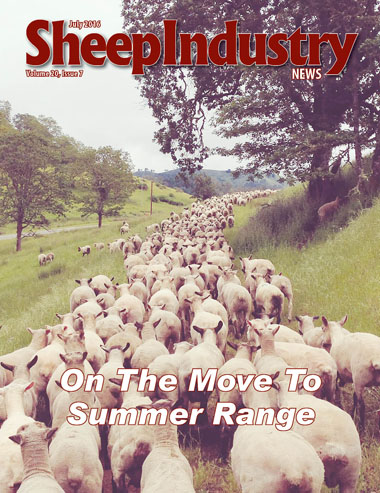
- July 2016
- President’s Notes
- Yellowstone Menus Offer Lamb
- ASI Comments on Behalf of USSES
- ASI Photo Contest
- Industry Recommends Research Priorities
- Sheep Center Sets Grant Deadline
- Sale Strengthens Lempriere
- Appropriations Update from Washington, D.C.
- Guaranteed for Life
- Young Entrepreneur: Sarah Spear
- CSU Vet Team Works Wyoming Ranch
- NSIP Offers Producers Online Tools
- Obituary
- Market Report
- Around the States
- The Last Word
NSIP Offers Producers Online Tools
TERRI QUECK-MATZIE
Special to the Sheep Industry News
Science and technology will grow the U.S. sheep industry. Through the efforts of the National Sheep Improvement Program, with backing from the ASI Let’s Grow initiative, producers are learning the benefits of genetic selection based on pedigree and production data. It’s a movement designed to increase quality and quantity of lamb meat and wool.
Bringing producers on board requires an innovative educational effort. For the past year, NSIP Program Director Rusty Burgett has made the rounds of meetings and conventions, presenting information and answering questions. He has provided on-farm demonstrations, and worked one-on-one with producers to introduce them to the world of Estimated Breeding Values and data collection. It’s a traditional extension agent approach to agricultural improvement.
Face-to-face meetings are effective. But they are not the only tool available in today’s world of digital communication. In 2016, nearly everyone owns a computer, and nearly everyone with a computer frequents social media. NSIP is no exception.
“We’re using technology to promote technology,” says Burgett. “More and more people are getting their information from social media channels and in the spirit of NSIP, we need to be on the leading edge of implementing technology.”
NSIP’s Facebook page boasts 2,000 likes and offers everything from Center of the Nation Sale consignment forms to national sale reports and industry updates, as well as conversation.
“The Facebook page provides a platform to not only post information but also to allow for feedback and start dialogue,” says Burgett. Such feedback is invaluable to Burgett as he tailors his in-person message and future efforts.
A second Facebook page, NSIP Marketplace, provides an online listing opportunity for those looking to buy and sell stock. Nearly 250 producers have used the marketing venue.
Now, NSIP has added a new electronic instrument – a YouTube channel. “The YouTube channel and Facebook pages were developed as a method to disseminate information about NSIP to a broader audience,” says Burgett. “Today’s producers, especially younger producers, are tuned to video. It’s a very effective way of telling a story.”
The channel launch is focused on producer profiles. The first features Irish Acres of Rio, Wisc., where Warren and Ellen O’Brion have farmed and raised Polypay sheep for nearly 30 years. The O’Brions are new to NSIP, and the four-minute video explains their introduction to the program and the benefits they’ve seen so far.
“The Irish Acres video demonstrates how the technology can be used in a maternal, farm flock situation,” explains Burgett. “It’s one example of EBVs at work.”
There are more to come. The producer highlight videos were produced thanks to funding from a Let’s Grow grant – part of the U.S. Sheep Genetic Improvement Initiative – and feature producers in different production systems throughout the country that are using NSIP to increase productivity and move the sheep industry forward. Within the first few days after posting, the Irish Acres video had more than 300 views.
“Other videos will be released in the near future focusing on using NSIP in fine-wool range operations as demonstrated by John Helle and family of Helle Rambouillets,” says Burgett. Hair sheep will be the focus of a third video. “This series demonstrates that NSIP can be used in a wide variety of production systems all across the U.S. and can help any flock advance its genetic merit and increase productivity.”
They’re meant to offer a taste of what NSIP can do, in producers’ own words, with more detailed information readily available on NSIP’s website.
The YouTube channel also offers tutorials on how to use NSIP technology and begin the data collection and submission process, through an NSIP webinar series recorded by Maryland Small Ruminant Extension.
The webinar includes:
• How the sheep industry can benefit from NSIP, by Dr. Robert Banks, with the Animal Breeding and Genetics Unit of New South Wales State Department of Agriculture and the University of New England.
• How the goat industry can benefit from NSIP, by noted goat expert Dr. Ken Andries of Kentucky State University.
• How, when and what data to collect, by American Lamb Board member and NSIP Vice President Cody Hiemke, Lamb Program Manager for Niman Ranch.
• Challenges of moving to a performance-based flock, by Bill Shultz, owner/operator of Bunker Hill Farm in DeGraff, Ohio.
• How to enter and submit data, by Chris Schauer, director and animal scientist at North Dakota State University Hettinger Research Extension Center.
The five sessions run around one hour each and provide a cache of detailed information and discussion. A sixth session features a producer panel discussion of practical application of the webinar information.
“And of course, YouTube provides links to related videos as well,” says Burgett. Tutorials on sheep genetics by Dr. David Notter, or genetic control of parasites in sheep and goats, are only a click away.
It’s all aimed at reaching as many people as possible with the resources available.
“The more people we can reach, the faster genetic improvement will take hold,” says Burgett. “At NSIP, we’re determined to spread the message by whatever means are available to us. Social media and digital communication are a natural fit for NSIP’s approach of using science and technology to lead us into the future.”
You can connect with NSIP by searching for National Sheep Improvement Program on YouTube or Facebook. Like and Subscribe to receive regular updates, and visit the website at NSIP.org for more information.

